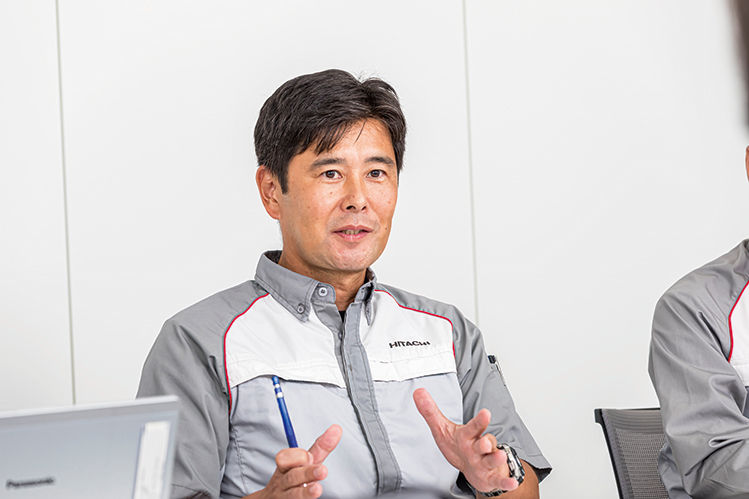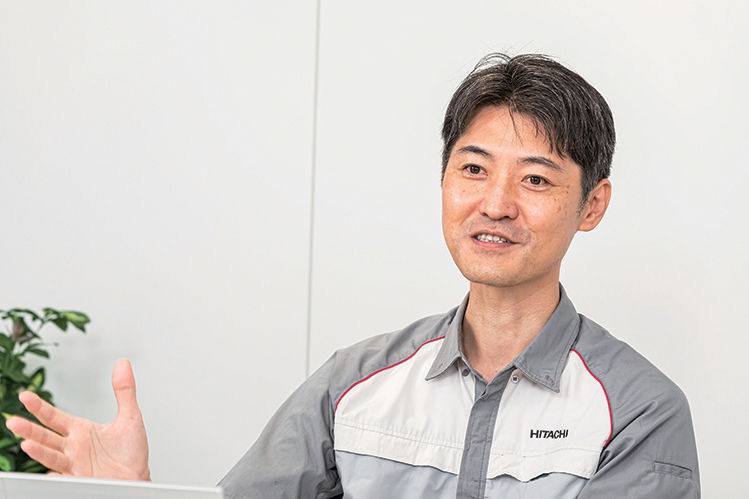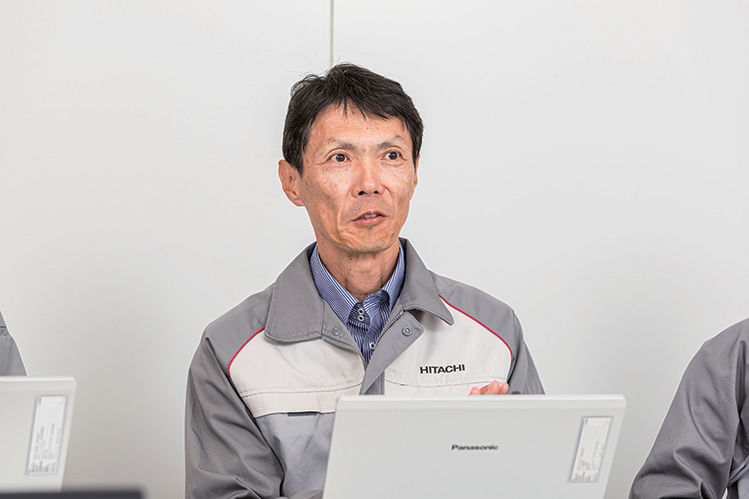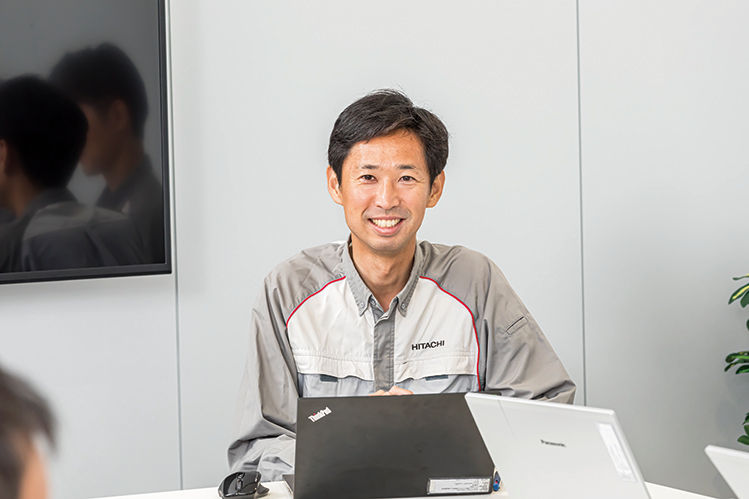HOW
Project Story
【Telescopic Arm (Rope Type) Machine 】
Hitachi Construction Machinery’s telescopic arm (rope type) machine was originally developed as an application development product at a customer’s request and is now known as our global brand. Here’s a case study about our telescopic arm (rope type) machine, with comments from the senior engineers in the New Products Development Department who worked on its development.

Akira Inamoto
Senior Engineer
New Products Development Dept.,
Development Div.
Construction Business Unit

Shigeya Tada
Senior Engineer
New Products Development Dept.,
Development Div.
Construction Business Unit

Atsushi Hoshino
Senior Engineer
New Products Development Dept.,
Development Div.
Construction Business Unit

Minoru Ito
Senior Engineer
New Products Development Dept.,
Development Div.
Construction Business Unit

Born through deep involvement with our customers’ project!
How our engineers keep challenging to develop application product
The application product development for Hitachi Construction Machinery’s telescopic arm (rope type) machine began in 1982, when we developed and delivered the first telescopic arm (cylinder type) machine for a customer who needed to dig deep to build the foundation of a transmission tower. Six years later, at the request of a customer in Hokkaido, we developed a telescopic arm (rope type) machine, significantly departing from the original telescopic arm (cylinder type) machine. This model was a major success and later became known around the world as “the Chameleon.”
“The arm of a telescopic arm (rope type) machine moves downward in tandem with a cylinder. It scoops soil from the ground and piles it in the dump truck. In large projects that require tunneling underground, the soil gets piled into dump trucks and carried off again and again throughout each day. Hundreds of cubic meters of soil needs to be transported away. This takes a long time to complete the project with a conventional hydraulic excavator, and there was a need to speed up the process to shorten the time. We identified that concern and began developing a model to address it. The result was our telescopic arm (rope type) machine. Rope is coiled inside the cylindrical arm, and the arm extends and retracts in tandem with a cylinder. This also reduces the cycle time, as it enables fast extension and retraction. This machinery surpasses conventional hydraulic excavators,” explains Akira Inamoto.
That’s the role of the New Products Development Department: meeting individual customers’ needs while modifying the base machinery of the standard products that are already on the market to provide functions that meet people’s needs.
“But many of customers’ concerns are vague,” says Shigeya Tada. “When we hear something from a sales rep who has consulted with a customer, members of the New Products Development Department look at the site for themselves, hear about what’s needed from the customer themselves and identify issues that haven’t been visualized yet. We work together with the sales reps. Sometimes we hold working groups with members from each organization to discuss technology and solutions to issues. We exchange information with other departments, get everyone’s ideas about what kind of functions would be useful, and then make a proposal,” Tada added.
Hitachi Construction Machinery’s New Products Development Department works closely with the sales team, and it’s not uncommon for development to be inspired by everyday conversations. “We get all the details about the customer’s site and the team discusses what kind of functions should be added and comes up with specifications and a structure,” says Inamoto. “That’s the basic process of our development.”
After discussing the specifications and structure for a modification of a standard hydraulic excavator, the department discusses their feasibility. For example, when adding a function to the front end of a machine, they thoroughly examine the strength and hydraulic pressure required to withstand that load and choose a suitable base machine.
“That is the difficulty at our development stage,” Tada explains. “When we pursue specifications to improve a function, it is always going to make the body heavier. So then the base machine goes up a class and obviously that makes it cost more. Because of this, a critical element of design is how compact and lightweight we can make the body to balance specs and cost.”

The 33 t class of our current telescopic arm (rope type) machine can dig up to 30 m deep. While increasing the size is an easy way to achieve deeper digging, there are limits to the weight of machinery that can enter a site. Not to mention that larger machinery costs more and consumes more fuel. And the customer’s focus is on the extension and retraction speed of the arm and the capacity of the clamshell bucket: the workload, in other words. Tada explains that they try to balance those factors to get the best design.
Here’s what Tada has to say about the behind-the-scenes development of our 30 m telescopic arm (rope type) machine. “Back when the deepest any of our machines could dig was 25 m, a customer said they wanted a telescopic arm (rope type) machine that could dig 30 m for a subway construction project overseas. At first we tried to attach a 5 m extension to the 25 m telescopic arm (rope type) machine, but this wasn’t very well received. So we went to the site again and again and developed and designed a 30 m telescopic arm (rope type) machine from scratch so that it would have the best structure possible. This time we got good feedback: the customer said that because the operation speed was faster and the bucket was bigger, they were able to work more efficiently at the site. This product is now used not only in Japan but in other countries too.”
Our products are one-of-a kind at the development stage. “We always go out to the factory and oversee the assembly of a product,” says Atsushi Hoshino. “When we deliver a product with a new function, we get the customer to try operating the new machinery at the site, and we take their feedback seriously.” He says there’s a sense of satisfaction and relief when the product the team designed is assembled and actually operated.
Our telescopic arm (rope type) machine began as a one-of-a-kind product, and has evolved as customers have used it and further improvements have been made. Despite initially being a custom development project, this product has been received so positively by customers that over 1,000 have been sold domestically and overseas. Its overseas projects include a recent subway line expansion project near the Temple Sagrada Família in Barcelona, Spain, and the construction of the HS2 high-speed railway network in the UK.
Minoru Ito, who is in charge of the telescopic arm (rope type) machine, has worked in the New Products Development Department the entire time he has been with us, and primarily works on model changes to improve the functions of our existing telescopic arm (rope type) machine. He explains how difficult it is to modify a machine that has already been completed: “If you change one thing, another issue appears somewhere else.” Adding a new function also increases the cost, so he makes sure to come up with a design that will make the cost acceptable to the customer. Development of application products is an exciting challenge for Mr. Ito: “I’ve worked on all kinds of products, so I have a variety of experience. I’m learning something new every day and I can see how much I’m growing because of it.”

